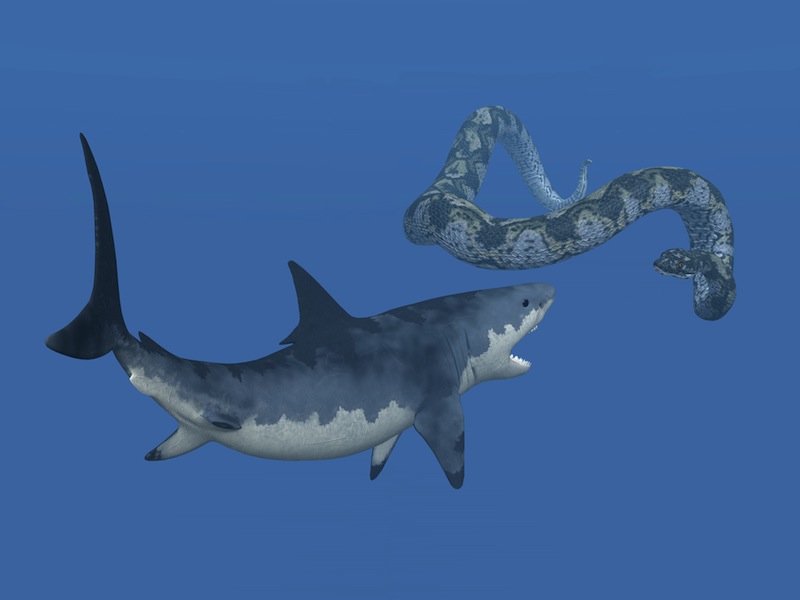Solved: When Earth's Largest Shark Disappeared

Giant, 60-foot-long (18 meters) Megalodon sharks used to lurk in the Earth's oceans, but while researchers are still unsure why these behemoths of the deep went extinct, scientists now have a better estimate for when it happened.
In a new study, researchers analyzed dozens of Megalodon (Carcharocles megalodon) fossils, and now estimate that the ancient shark, the largest to ever live, likely went extinct about 2.6 million years ago.
This date falls on the border between the Pliocene and Pleistocene Epochs, right when baleen whales began growing to their modern-day gigantic sizes. The timing of the Megalodon's extinction makes sense, since these ancient sharks fed on marine mammals, including whales and dolphins, the researchers write in the paper. Without the presence of a predator, the baleen whale could flourish. [Wipe Out: History's Most Mysterious Extinctions]
Megalodon's disappearance
It's difficult to pinpoint the exact date the Megalodon went extinct, because its fossil record is incomplete, the researchers said. Scientists have developed ways to determine the last appearance date of an animal, based on the most recent fossils it left behind. Most Megalodon fossils date back to the middle Miocene Epoch (15.9 million to 11.6 million years ago) and the Pliocene Epoch (5.3 million to 2.6 million years ago). The researchers identified 42 of the most recent fossils after sorting through the Paleobiology Database – a large online compilation of fossil data.
The team used the Optimal Linear Estimation (OLE) technique to estimate when the Megalodon died out. But applying this technique to the fossil record can be tricky, the researchers said. Each of the 42 fossils is entered into the database with an upper and lower date estimate for when it appeared. The researchers ran 10,000 simulations, and each simulation selected a date for each fossil somewhere between the upper and lower boundary.
The technique examines the spacing between the fossil dates, said Chris Clements, a research assistant at the University of Zurich, who worked on the study.
Get the world’s most fascinating discoveries delivered straight to your inbox.
"Based on the distribution of those gaps and how those gaps change, it will then infer the point in time where that species can be considered to be extinct," Clements told Live Science.
The technique doesn't pinpoint the exact date when a species went extinct, but instead gives the date by which, statistically, it can be assumed that a species has gone extinct, Clements said.
"We get 10,000 estimates for the time the species has gone extinct by, and then we look at the distribution of those estimates through time," Clements said.
The idea is to identify the point where most of the estimates cluster. The results for the Megalodon fossils placed that point for this species at 2.6 million years ago. [Image Gallery: Ancient Monsters of the Sea]
Megalodon is definitely extinct
Six of the 10,000 simulations place the giant shark's extinction beyond the present day, suggesting the species could still be alive. However, since 99.9 percent of the simulations suggest the species is long gone, the researchers wrote in the new study that they reject "the popular claims of present-day survival of C. megalodon."
Those six estimates past the present day come from the uncertainty in the fossil record dates, Clements said. Among the 10,000 simulations, there are a few that end up with such widely spread fossil dates that the estimated time of extinction is projected to be close to or past the present day.
"It definitely doesn't mean that the species is still alive," Clements said.
The Discovery Channel's wildly popular Shark Week programming perpetuated the idea that the Megalodon could still exist. The series kicked off last year with a documentary-style special called "Megalodon: The Monster Shark That Lives," which the network followed up this year with a feature called "Megalodon: The New Evidence."
However, marine scientists agree that the shark is long gone. After this year's Shark Week, David Shiffman, a graduate student at the University of Miami who has become a social media authority on sharks, wrote in a Slate.com blog post that "there is absolutely no doubt whatsoever that these sharks are extinct and have been for millions of years. If a 50-foot-long predator that fed on surface animals and lived in coastal environments were still around, someone would have found evidence of this by now."
The new findings are published online today (Oct. 22) in the journal PLOS ONE.
Follow Kelly Dickerson on Twitter. Follow us @livescience, Facebook & Google+. Original article on Live Science.

